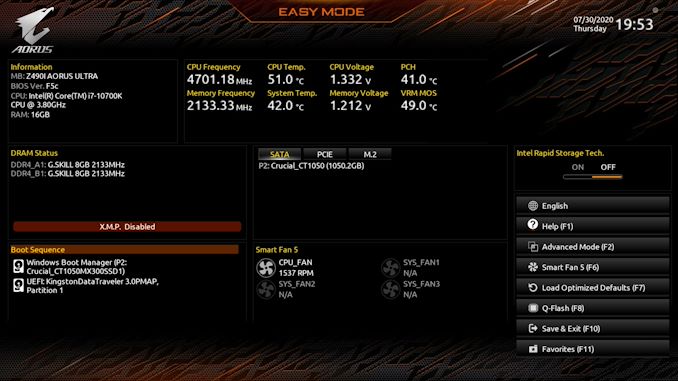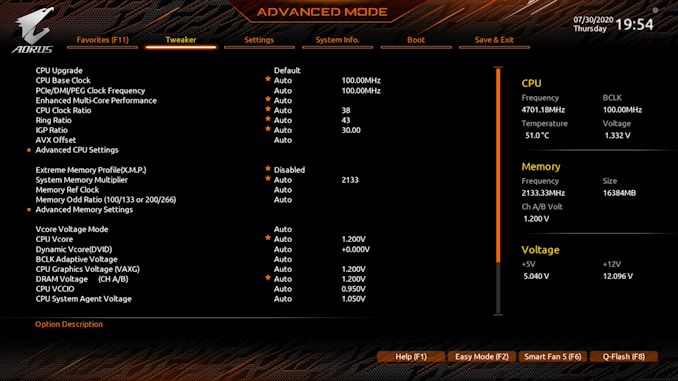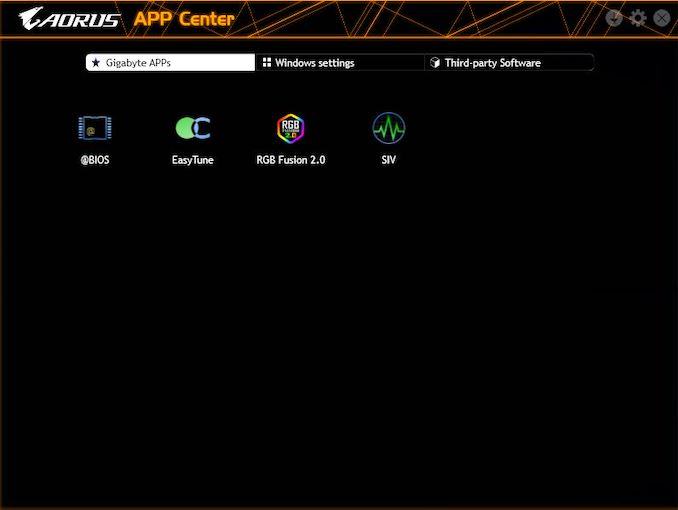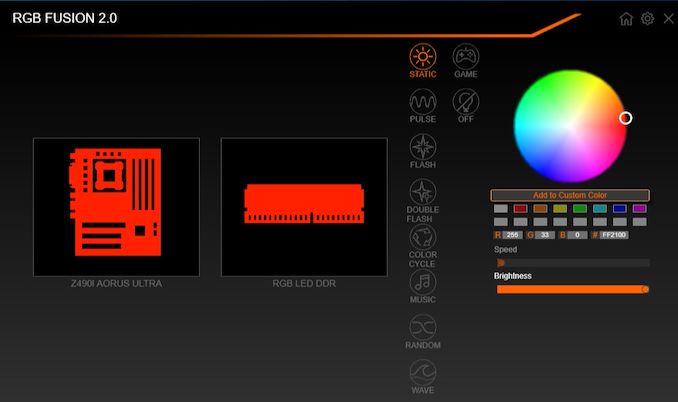The Z490 Mini-ITX Showdown: GIGABYTE's Z490I Aorus Ultra and MSI's MEG Z490I Unify Reviewed
by Gavin Bonshor on August 4, 2020 10:30 AM ESTGIGABYTE Z490I Aorus Ultra BIOS
The firmware on the GIGABYTE Z490I Aorus Ultra uses a black and orange contrasting theme, with white text and dark orange highlights. The firmware itself has two primary modes, Easy mode and the advanced mode which users can access by pressing the F2 key.
Upon first boot and entering the BIOS, the Easy Mode displays an essential list of information including the version of the firmware being used, the installed processor, as well as information pertaining to the CPU frequency, temperatures and basic voltages. To the bottom left-hand corner, users can change the boot sequence order, while the right-hand side displays a list of menus which can be accessed by pressing the corresponding key.
In the advanced mode, users can tweak and perform overclocks on both the CPU and memory, as well as access more intricate parts including GIGABYTE's Smart Fan 5 utility and chipset related options. There's plenty of options for users to get to grips with including an extensive list of CPU and memory frequency, memory latency and voltage settings. Other options included within the firmware also stretch to integrated graphics frequency, as well as settings for changing the ring and base-clock frequencies. For enthusiasts, GIGABYTE includes power-related options for Intel's VF Curve and power profiles, as well as settings to change the power delivery and load-line calibration settings for tighter or slacker VDroop control.
The GIGABYTE Aorus firmware in itself is easy to navigate and use, although the menus are quite stacked and somewhat cramped. This can be intimidating for users without much in the way of organization of the Tweaker menu and opts to just list all of the settings, as opposed to placing them in individual sections for CPU, memory and voltages. GIGABYTE is consistent with its firmware and it is responsive and intuitive.
GIGABYTE Z490I Aorus Ultra Software
All of GIGABYTE's software package revolves around the Aorus App Center which adds as a central hub for all of its software offerings. It also provides access to a multitude of Windows-related settings including power options, network settings, and the integrated Windows Firewall.
Some of the most notable inclusions with the Z490I Aorus Ultra include the @BIOS firmware updating application, the EasyTune software, GIGABYTE's RGB Fusion 2.0, and the System Information Viewer or SIV software.
The EasyTune software allows users to perform in operating system overclocks, with plenty of options for changing the CPU frequency, base clock frequency, and related voltage settings. Users can opt to overclock the CPU on a per-core basis in 100 MHz increments, or sync all-cores for more hardened and heat-intensive overclocks. There are also options to change the memory frequency on the fly as well as DDR4 primary latency timings, as well as alter the CPU VCore current protection for users looking to perform big overclocks, although with Comet Lake running hot even at stock settings due to great turbo clock speeds, this is more for the enthusiasts with beefier cooling setups.
GIGABYTE's software omits any form of audio software, although users can download the Realtek Audio Center direct from the Microsoft store. Users can alter and create disco-inspired light shows with the integrated RGB Fusion 2.0 software, as well as customize additional RGB LED strips which can be purchased separately. Users can even sync compatible RGB memory with the integrated LEDs for a more uniformed look.
Overall the GIGABYTE software package is basic, but it provides extra user experience and offers customization of styling, as well as overclocking. Despite advancements in overclocking software, we still recommend users do all the CPU and memory overclocking within the BIOS.



























21 Comments
View All Comments
hansip87 - Tuesday, August 4, 2020 - link
In my country these boards are just plain expensive. Instead i went with Asrock Z490M ITX AC with 10400f. which like half the price of these boards. I know VRM not as good but for actual tiny build who really cares?Beaver M. - Thursday, August 6, 2020 - link
ASRock is pretty awesome with ITX boards. Its still sad that they dont do their ITX-E series anymore, though.The much bigger problem is their 10+ year old issues with long or extended USB cables losing connection from time to time or not working at all. No other manufacturer has those issues.
Back in the day you could at least dodge it by using the extra USB chip onboard for devices that had longer or extended cables, which handled newer USB standards, but nowadays they are all integrated by Intel, and thus they all have the same issue on ASRock boards.
artifex - Friday, August 7, 2020 - link
If you're not overclocking, I'll bet it's fine.Tomatotech - Tuesday, August 4, 2020 - link
Nice review. But I’m not sure who in AnandTech’s readership is going to buy these boards. Intel sales to the DIY / home build sector are dropping off a cliff - most of the top selling CPUs on Amazon are now AMD.Showtime - Monday, August 10, 2020 - link
I'm sure lots of people at AT are into ITX . Intel hasn't fallen off that much. AMD simply has louder fans. You couldn't find a 10600k for months, and Intel sales are strong going by pricing. I noticed this article because I was looking at an i7 10700 over a 3700x. They trade blows with the 10700 being slightly better at gaming at basically the same overall price (CPU/Mobo/RAM). So AMD may have the 6 core, and lower covered, and the higher counts covered, but somehow that vanilla 10700, that AT did meh review on, ends up being a better buy than the very popular 3700x for me.Koenig168 - Tuesday, August 4, 2020 - link
Waited quite a while for this review. Gigabyte has done a really impressive job with VRM cooling recently. While I like the Unify for its aesthetics, I could have done without the VRM fan and would prefer instead a beefier passive cooler. Now if MSI could fix that and replace the Intel chipset with an X570 or B550, that would be perfect. :)Beaver M. - Thursday, August 6, 2020 - link
The first thing I look at especially ITX boards (since you cant just add an addon USB slot bracket) is the amount of USB ports.MSI fails completely at that.
Gigabyte isnt much better though, because they messed up the audio connections.
Also ITX boards shouldnt waste that much space with SATA ports anymore. 2 are more than enough.
Fixed WIFI is bad too. I know its integrated nowadays in Intel chipsets, but standards change and some people dont need WIFI at all, or need to use USB WIFI anyway, because they need to position their antennas far away. Wasted space on the backplate and PCB.
Also they are completely overpriced.
JlHADJOE - Friday, August 7, 2020 - link
All I really need to know here is how MSI treats the smaller reviewers like crap, which automatically disqualifies them in my book for the next 5-10 years.Oxford Guy - Saturday, August 8, 2020 - link
The names of these products are preposterous.saol - Sunday, August 9, 2020 - link
Hope there will be the B550 mini-ITX showdown.